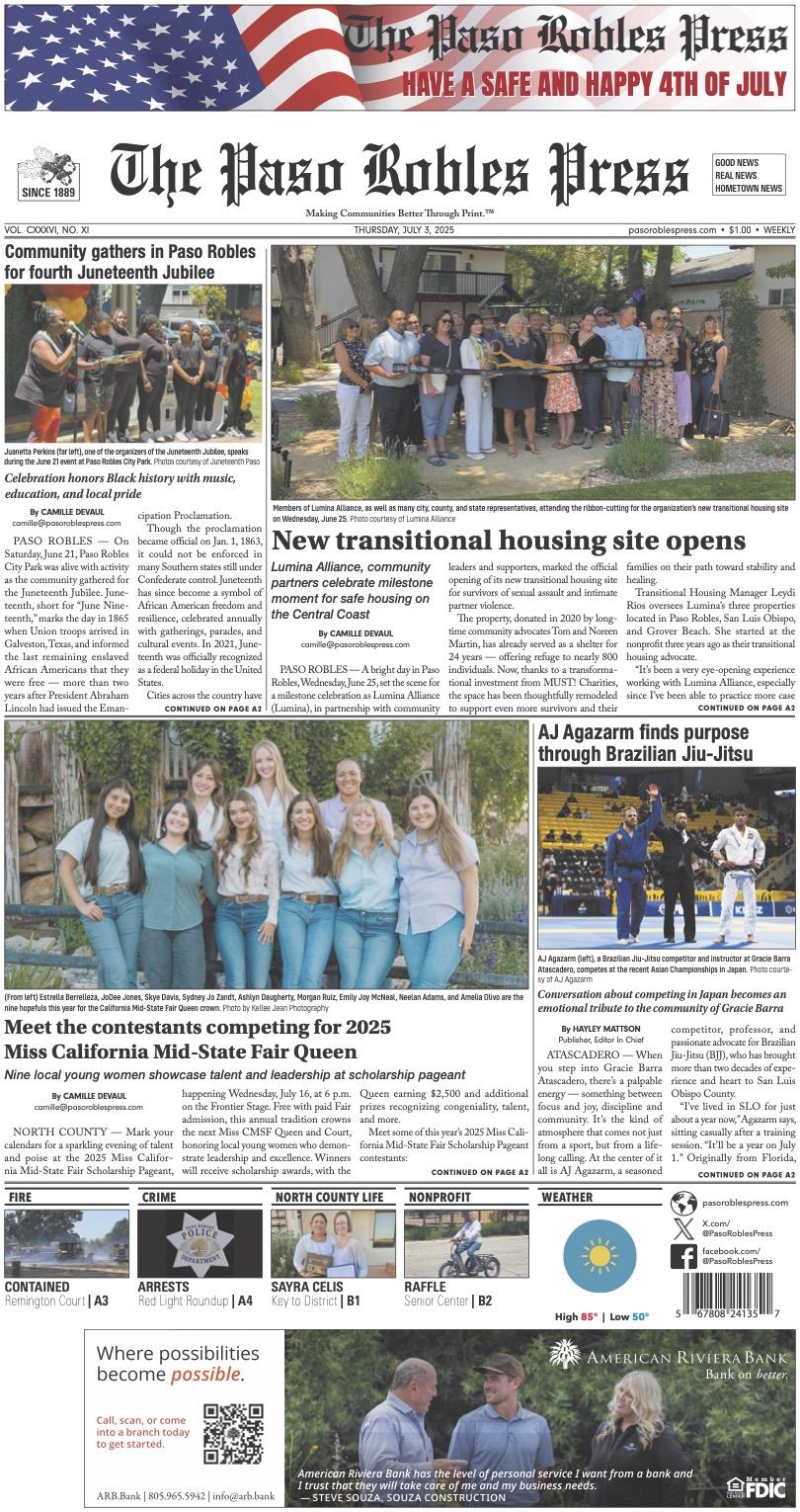By Brian Maxted
Guest Contributor
With more than 600 students in grades kindergarten through fifth, Paso Robles’ Dual Immersion Program, Georgia Brown, currently housed at its namesake campus at 36th Street, has grown to become the district’s largest and most sought after elementary school program. Until recently, switching to a lottery system to handle demand, parents from all over Paso Robles and beyond would camp out overnight to secure their children’s spot in the program that grounds the fundamentals of their child’s educational journey in both Spanish and English. Its administration is excellent, with its principal, Celia Moses, recently being awarded Woman of the Year, long-tenured teachers with experience teaching in both languages, and outsized results, including leading the district in EL Student’s Progress in recent statewide tests by a phenomenal 19.3 percent compared to the districtwide average of 2.9 percent.
However, the program’s success can be attributed to more than simply language — it is a reflection of the Paso Robles community, where diverse racial, socioeconomic, rural, and more urban backgrounds choose to send their children on a shared adventure of academic, cultural, language and social exploration and unity. In 2024, Georgia Brown is achieving what many parts of our country sorely lack — choosing to come together regardless of background. The program is also a policy success and a rare beast, both empowering parents (those lucky enough to receive a winning lottery spot) with school choice, while celebrating different cultures and leaning into diversity.
The results speak for themselves: The Dual Immersion Program has grown over the years and is now 66 percent larger than any other district elementary school program and remains oversubscribed, where all other elementary and middle school campuses are substantially under capacity. Specifically, all five of the other public elementary schools in the district have substantial available space in their existing facilities, with each campus underutilized with between 44-66 percent of design capacity utilization.
Curiously, the only other elementary schools in Paso Robles that are at capacity and/or have a waiting list include the one charter school (Almond Acres) and both private schools (St. Rose and Trinity). The reason behind such decreases in enrollment have a lot to do with demographics; specifically, Paso Robles is becoming more expensive, pricing out many young families from settling or staying in the district often in exchange for retirees who choose the location for its great weather, bucolic roots, and exploding wine scene, and who can afford the price tag. Many of the demographics of the few new families moving into the district consist of either agricultural workers, often from a native Spanish-speaking family, or teleworkers who have fled the chaos of urban areas for the sanity, high quality of life, and relative prosperity of Paso Robles.
In all cases, parents are seeking the best choices for their children’s education, and the Dual Immersion Program, as well as other programs that empower the parents to choose what kind of educational experience they deem best for their child, is and could continue to be a draw to young families moving to Paso Robles. Ultimately, the district has a generational challenge on its hands — how to manage a declining number of overall school-aged children with existing infrastructure and resources while maximizing the educational experiences for families in the community.
The district’s track record in the recent past of managing these precious and decreasing resources has been so detached from reality and effective governance that in 2020, a San Luis Obispo Grand Jury released a report titled “Paso Robles School District: A Cautionary Tale” evaluating the Paso Robles School District’s financial crisis at the time as having represented “failures in leadership and management” and provided a “detailed illustration of how a school district can inadvertently fail its students and the community it serves.” The report stated, “that [the District’s] collective failures to control or report on excessive expenditures created a fiscal crisis that will take time and hard work to resolve.” The report further detailed that between 2014 and 2018, the district’s reserves declined from about 10 percent of the annual budget, or more than $6 million, to approximately 0.4 percent of the budget. Some of the school board has turned over since 2020, and the district is still building back both reserves, and credibility, from those dark days.
All the while, the Dual Immersion Program has flourished despite being resource-neglected for decades. In talking to some, there used to be a large overcurrent (and perhaps now, more of an unspoken undercurrent in some corners) that only English should be taught in our elementary schools. At the center of this controversy is the physical campus at 36th Street, originally built in 1948; the campus is beyond its useful life and in a shameful state of disrepair, with real questions about health and safety, including mold, pest infestations, leaky roofs, broken heaters, and air conditioners; and structural concerns where entire wings consists of unreinforced masonry and aging structural supports that may not hold as well in the next large earthquake. Not to mention that as part of an exploratory environmental impact report for renovations, it was discovered that the entire 36th Street campus sits on a geological anomaly that may make building on the site in the foreseeable future well-delayed to potentially unfeasible. Is it a coincidence that the school located in one of the lowest income parts of Paso Robles is one of the oldest campuses, the last to be renovated, and kept in a state of disrepair for shamefully long?
In the upcoming weeks, the school board is going to make its fourth plan in five years on where to physically accommodate the Dual Immersion Program. Although the district states that it is dedicated to the success and continuation of the Dual Immersion Program, actions speak louder than words. Instead of prioritizing its largest and most sought after program that is bringing real choice, diversity, and results to the district, the options currently being discussed most by the board and the district Advisory Committee include 1.) keeping the Dual Immersion Program on a crumbling 36th Street campus that is busting at its seams and presents ever-growing health and safety concerns; 2.) dividing the Dual Immersion Program into multiple other elementary school campuses, fracturing its unique community and risking diluting or disintegrating its success; or 3) shoving over 600 students into the undersized temporary trailer campus next to Flamson on 24th Street that will be an absolute traffic nightmare, and having no line of sight on a permanent home or confirmation that funds actually exist to build one.
All three of these solutions severely put at risk the continued success of the program. Is the assumption that because the program is so popular, community parents will just deal with ever-growing risks to health and safety? Is there a further assumption that excellent teachers and administrators will just grin and bear continued neglect, displacement, and disruption without a permanent solution? As a parent in this community engaged with other Georgia Brown parents and teachers alike, I know for a cold, hard fact that the above current options being discussed put in real jeopardy one of the crown jewels of the Paso Robles School District.
What else is the district taking for granted in this gambit beyond a successful, bilingual, multicultural, and diverse social economic success? Money. Each enrolled student in a public elementary school brings about $14,000 per year in state tax money to the district. This tax money not only helps augment teacher salaries, but provides resources for administrators, infrastructure, and ongoing expenses. The Dual Immersion Program has nearly 70 students from partner districts in the greater unified school district, namely Templeton, San Miguel, and Atascadero. This means that the Dual Immersion Program is bringing in nearly a million dollars a year from neighboring districts into the Paso Robles School District. For an area that is facing declining school-aged demographics, underutilized campuses, and past and potential future budget shortfalls, the Dual Immersion Program is the golden goose that the district has been plucking to feed whatever it is they have been doing at the detriment of its largest, most diverse, and most in-demand program.
What would happen if the Dual Immersion Program left Paso Robles altogether? Hypothetically, the program could move its experience, administrators, teachers, and families seven miles up the road to the San Miguel district, which with its native-speaking Spanish population would well meet the demand and state’s requirements of a 50 percent native Spanish speaking student body. Imagine 300 students up and leaving for San Miguel — that is more than $4 million in state tax dollars that would leave the Paso Robles School District. What if all 600 students left? Hypothetically, what if the Dual Immersion Program merged with or sought charter status similar to Almond Acres? Again, those tax dollars would leave the district with those students and make the challenge of managing a district with underutilized assets and a declining school population substantially worse.
And yet, there are multiple solutions that embrace this highly successful and long-neglected community and help fortify the district during this period of overall decline of school-age enrollment and potential upcoming budget shortfalls. These solutions include 1.) movement of the Dual Immersion Program to Winifred Pifer or Bauer Speck campuses and redistribute school boundaries of those campuses to other elementary schools or 2.) consolidation of either middle school campus and placing the Dual Immersion Program in either Flamson or Lewis middle schools and perhaps, with a little bit of vision, extending the Dual Immersion Program through eighth grade to both alleviate the pressure on just one middle school campus and lean into the strength that the Dual Immersion Program brings to the district. What if the district brought sixth grade back to elementary schools and moved the Dual Immersion Program into one of the two middle schools? Sure, this would involve some change management, but plenty of school districts around the country have sixth grade as part of elementary school and such a move would evenly distribute those rising sixth-graders throughout the open seats on their existing, non-crumbling, elementary school campuses. Any of the above choices would be a better use of existing resources and leaves potential capital dollars to either allocate to other worthy programs like a.) the half-designed and partly purchased student aquatics center; b.) build a more manageably sized elementary or middle school, if needed, at the 36th street campus; c.) and/or fortify the district’s balance sheet at a time where the state as a whole is facing a $37 billion budget shortfall, which includes $15 billion of unplanned K-12 budget cuts. To assume that Measure M (state school-related infrastructure tax dollars) will be available when and in the amount needed to build an entirely new campus large enough to house the existing and future Dual Immersion Program demand places such aspirations in the hopes-and-prayers category. Especially given the district’s recent track record of financial instability, outlaying tens of millions of dollars to build a large campus that it does not necessarily need (either in size or potential at all in the near future), which seems like the Groundhog Day of fiscal irresponsibility.
Talk about consolidation of campuses brings understandably emotional reactions from those with school-aged children, residents living in the surrounding area, and the teachers and/or administrators the decisions would affect. However, whether in business or government, leaders are put in place to lead, which often means making hard choices with limited resources and taking into consideration what is in the best interest of all stakeholders. Emotional sentiments are important, but putting safety and mission first, wisely using resources, building on strengths, and managing and empowering the human capital is paramount to the success of any large organization. Effectively making a change is about shepherding past the perceived hardship of something like a move or consolidation and remembering that these choices are made primarily for the benefit of all the children in our community to attend a safe and healthy learning environment and to empower parents with the educational choices they seek for their children — not necessarily tied to any one particular name, building, or location.
I have watched the leadership in Paso Robles make hard decisions before regarding business continuity during COVID and whether CRT should or should not be taught in our district. And whether you agree or disagree with their decision in such instances, our leaders listened to all stakeholders, and took a position on what they felt was in the best overall interest for our community. But indecision of a temporary campus is also a decision, and continual neglect of the Dual Immersion Program and the communities it supports is risking one of the district’s best success stories, underutilizing existing resources, and showing no clear vision for what they want the school district to be or become. Ultimately, the challenge I present to the Paso Robles District School Board: Do not simply be reactive to one constituency’s or another’s loudest squeaky wheels but rather take this opportunity to further clarify the district’s mission and vision, take the demographic trends seriously so we can maintain all our hard working teachers and administrators, keep the children and parents who trust them with their children’s education first and foremost in mind, be wise with limited resources (especially given past indiscretions), and use the need for change to drive innovate solutions.
For me, the choice is clear, although the big shiny new building for the Dual Immersion Program at 36th street sounds, in theory, incredible, I do not believe it is justified at this time given the available room in the district, declining future demographics, and past and future budget challenges. And if we keep dangling this out to stakeholders as if it’s a real or responsible reality, it will also delay the hard and prudent choices.
Unquestionably, allowing students to go to school in the conditions that exists on the 36th campus is shameful and a dereliction of basic duty. Placing our largest, most diverse, most sought-after, and highly successful elementary school program in a temporary campus with no certainty of permanence is incompetency that would bankrupt any successful business and risks tearing this beautiful success story at its seams. The district needs to choose a consolidation path, start planning immediately to be carried out no later than the beginning of next school year or perhaps sooner if the conditions at the 36th Street deteriorate further, and stick to it through the noise carrying hearts and minds along the way. And use the process to sharpen your vision of what you want the district and its programs to be beyond shiny new buildings. Paso Robles was built on common sense, a community coming together to overcome obstacles, and a dash of maverick boldness — now more than ever, we need that spirit driving the solutions for a better Paso Robles School District for generations to come.
Brian Maxted is a Paso Robles resident, parent of two Dual Immersion Program students, and CEO of a local company in Holloway.










